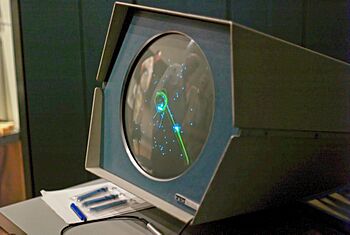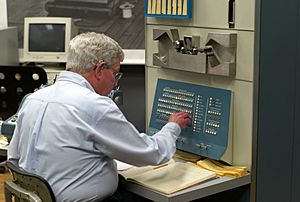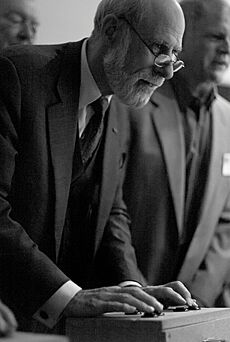Spacewar! facts for kids
Quick facts for kids Spacewar! |
|
|---|---|

Spacewar! on a PDP-1
|
|
| Designer(s) | Steve Russell |
| Programmer(s) | Steve Russell |
| Platform(s) | PDP-1 |
| Release date(s) | April 1962A |
| Genre(s) | Space combat |
| Mode(s) | Multiplayer |
Spacewar! is an exciting space combat video game. It was made way back in 1962! Steve Russell and his friends created it. They worked at the Massachusetts Institute of Technology (MIT).
The game was built for a new computer called the DEC PDP-1 minicomputer. After it was first made, other students helped make it even better. Spacewar! became very popular. It was played on many PDP-1 computers. This made it one of the first video games played in different places.
In the game, two spaceships fight each other. They are called "the needle" and "the wedge". Players control these ships. They fly around a star, which pulls them with gravity. Each ship has limited weapons and fuel. Ships keep moving even if you don't accelerate. Flying close to the star could give you a speed boost!
Ships are destroyed if they hit a torpedo, the star, or each other. Players can also use a "hyperspace" feature. This moves their ship to a new, random spot on the screen. But sometimes, using hyperspace could destroy the ship! At first, players used switches on the computer. Later, a special gamepad was made to make playing easier.
Spacewar! is a very important game in the early history of video games. Many programmers loved it in the 1960s. The game's code was free for anyone to use. People copied and changed it for other computers. It inspired many other games. These include the first arcade games, Galaxy Game and Computer Space. It also inspired later games like Asteroids.
In 2007, Spacewar! was named one of the ten most important video games ever. It helped start the game canon at the Library of Congress. In 2018, it joined the World Video Game Hall of Fame.
Contents
How Spacewar! Was Created

In the 1950s, people started making computer games. These games often showed what computers could do. They were also for fun! Students and workers at places like MIT made these games. They could use special computers like the TX-0.
These early games were interactive and had graphics. A group of programmers, many from the Tech Model Railroad Club, made them. Games like Tic-Tac-Toe let you play against the computer. Mouse in the Maze let you draw a maze for a virtual mouse.
In 1961, a new computer arrived at MIT. It was the DEC PDP-1 minicomputer. It had a screen and switches for input. Before it arrived, some students thought about new programs. Steve Russell, Martin Graetz, and Wayne Wiitanen came up with Spacewar!.
Russell told Rolling Stone magazine in 1972: "We had this brand new PDP-1. It could do amazing things!" They wanted to make a game that showed off the computer. They decided on a two-dimensional spaceship game.
Playing the Game: Spacewar! Gameplay
Spacewar! lets two players control spaceships. One ship is "the needle," and the other is "the wedge." Players try to shoot each other. They fly in a two-dimensional space. A star in the middle pulls ships with gravity. The background shows a field of stars.
Ships fire torpedoes, which are not affected by gravity. Each ship has a limited number of torpedoes and fuel. Fuel is used when you fire your thrusters. Torpedoes are fired one at a time. There's a short wait before you can fire again. Ships keep moving even if you stop accelerating. Rotating your ship doesn't change its direction of travel.
Players must shoot the other ship. They also need to avoid hitting the star or the other ship. Flying close to the star can give you a gravity boost. But be careful not to fall into the star! If a ship goes off one side of the screen, it comes back on the other side. This is called a wraparound effect.
There's also a "hyperspace" feature, or "panic button." You can use it to escape enemy torpedoes. Your ship disappears for a few seconds. Then it reappears somewhere else on the screen. But where it reappears is random. In some versions, using hyperspace too much could make your ship explode!
Players control their ships by turning left or right. They can also thrust forward, fire torpedoes, and use hyperspace. At first, players used switches on the PDP-1 computer. But these switches were hard to use. They also wore out quickly. So, Bob Saunders made a special control device. This was an early gamepad. It had switches for movement and a button for firing. The fire button was silent so the other player wouldn't know you were about to shoot.
Making the Game: Spacewar! Development

Russell, Graetz, and Wiitanen thought up Spacewar! in the summer of 1961. Russell had read the Lensman series of books. He thought the space battles would make a great game. Other ideas came from Japanese tokusatsu movies.
When the PDP-1 arrived, programmers learned how to use it. Russell often talked about his game idea. He hoped someone would make it. But others thought he should do it! Russell made excuses, like needing a math program for ship paths. Alan Kotok from the TMRC called DEC. They had the math program! Kotok brought the program to Russell. Russell then started coding around December 1961.
The game had three main goals:
- Use as much of the computer's power as possible.
- Be interesting every time you play.
- Be fun and entertaining.
It took Russell and his friends about 200 hours to make the first version. This was about six weeks of work. They wrote it in the PDP-1's assembly language.
By February 1962, Russell had a working game. It had spaceships that could rotate. The ships looked like a curvy spaceship from Buck Rogers and a PGM-11 Redstone rocket. Russell added a random starfield background. This helped players see how fast ships were moving.
The programmers at MIT shared their work freely. This was part of the "hacker ethic." Everyone helped make the game better. Peter Samson, a TMRC member, improved the starfield. He used real star charts! His program, "Expensive Planetarium," showed real stars. Russell added it to the game in March.
The first game didn't have the star's gravity or hyperspace. Dan Edwards and Martin Graetz added these features. They wanted to add more strategy to the game. Russell had wanted gravity, but it was too slow. Edwards made the drawing faster. This freed up power for gravity calculations.
The first hyperspace had a limit of three jumps. Later versions removed the limit. But they added a risk: your ship might explode! In March 1962, Saunders made the gamepads. This helped players avoid "Space War Elbow" from hunching over the computer.
Spacewar! was only for two players. The computer didn't have enough power for a computer-controlled ship. Other ideas, like better explosions, were also too much for the computer. Russell even added and then removed a feature where torpedoes shot differently. Players didn't like it!
By April 1962, the game was ready to show off. They added a time limit and a second, larger screen for viewers. The game was a huge hit at MIT! The lab even had to limit playtime to lunch and after work. Visitors loved playing the "lovely game."
Starting in 1962, Spacewar! began to spread. Programmers moved to other universities and companies. They took the game with them. This made Spacewar! one of the first video games available in many places. Other programmers made their own versions. Some added more ships or a cloaking device. Some even made a first-person version!
DEC, the company that made the PDP-1, used Spacewar! to show off their computers. They even published a brochure about it. The game was so good, DEC technicians used it to test new PDP-1s. It was the only program that tested every part of the computer!
However, the PDP-1 was very expensive. It cost about $120,000 in 1962. Only 53 were ever sold. Many went to military or research labs. This meant Spacewar! could only be played by a small group of people. Even later DEC computers that came with Spacewar! pre-loaded didn't reach a huge audience.
Spacewar! Today: Its Impact and Legacy

Spacewar! was very popular among programmers in the 1960s. It was copied and remade on many different computers. The game was in the public domain. This means anyone could use or change its code. No one tried to sell it. The programming community was too small for a game business.
The game spread as people shared copies of the code. Programmers also remade it from scratch. Early places to get the game included Bolt, Beranek, & Newman and Stanford University. The game was so popular at Stanford that they made a special "Spacewar mode." This let people play while other research programs ran.
Computer scientist Alan Kay said in 1972 that Spacewar! "blossoms spontaneously wherever there is a graphics display connected to a computer." This means it popped up everywhere computers had screens.
Most of the game's spread happened after 1967. That's when computers with screens became more common. By 1971, there were over 1000 computers with monitors. This allowed Spacewar! to reach more people. Many game versions were made around this time. In 1972, Rolling Stone magazine even held the "Intergalactic Spacewar! Olympics." This was the first video game tournament ever!

In the early 1970s, Spacewar! moved from big computers to arcades. It inspired the first coin-operated video games. Hugh Tuck thought a coin-operated Spacewar! would be a hit. But computers were too expensive then. In 1971, Tuck and Bill Pitts made Galaxy Game. It used a PDP-11 computer. They only made two prototypes.
Around the same time, Nolan Bushnell and Ted Dabney made Computer Space. This was also based on Spacewar!. Computer Space became the first arcade video game sold to the public. Many players thought both arcade games were just better versions of Spacewar!.
Byte magazine published a version of Spacewar! in 1977. It ran on smaller computers like the Altair 8800. It used an oscilloscope for the screen. Modern versions of the game have also been made. In 2012, an online version was made. You can play it using a JavaScript PDP-1 emulator. The Analogue Pocket handheld console can also run Spacewar!.
The only working PDP-1 computers are at the Computer History Museum in California. They give demonstrations there, and you can play Spacewar!.
Spacewar! had a huge impact. It inspired many other games. These include Orbitwar (1974), Space Wars (1977), and Space War (1978). The game Asteroids (1979) used ideas from Spacewar!. These included the hyperspace button and the ship's shape. Even games like Star Control (1990) were inspired by it. Steve Russell was most proud that his game inspired so many other programmers. They felt free to create their own games.
On March 12, 2007, The New York Times said Spacewar! was one of the ten most important video games. These games were chosen to be saved at the Library of Congress. In 2018, it was added to the World Video Game Hall of Fame. Also in 2018, the people who helped make Spacewar! received a special award. It was the Pioneer Award from the Academy of Interactive Arts & Sciences.
Images for kids
-
Steve Russell, designer and main programmer of the initial version of Spacewar!, with a PDP-1 in 2007
-
Front panel of a PDP-1, featuring paper punched tapes in a holder, a punched tape reader, and the computer's control panel
-
Vint Cerf playing Spacewar! on the Computer History Museum's PDP-1 at a 2007 ICANN meeting
-
Spacewar! on the Computer History Museum's PDP-1 in 2007
See also
 In Spanish: Spacewar! para niños
In Spanish: Spacewar! para niños








